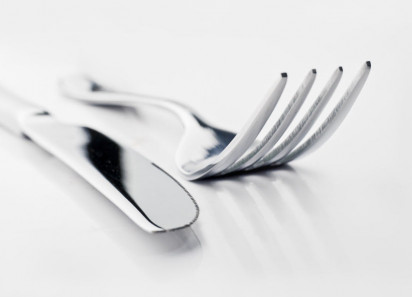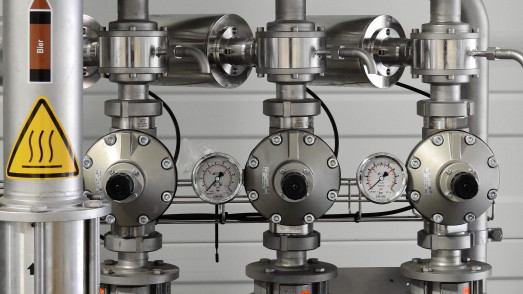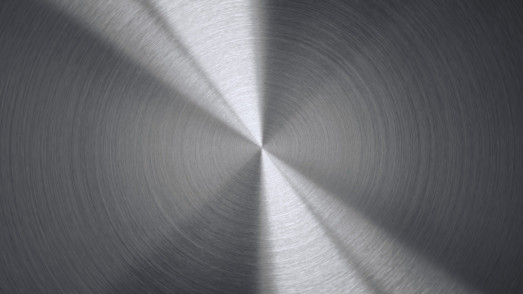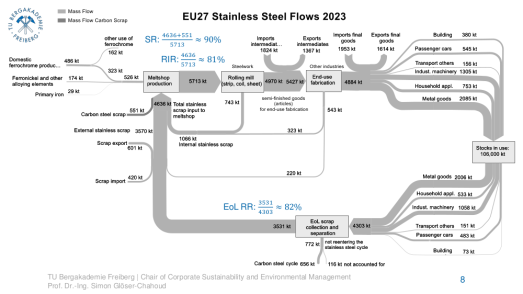Overview
Stainless steel is the term used to describe a remarkable and extremely versatile family of engineering materials, which are selected primarily for their corrosion and heat resistant properties.
All stainless steels contain a minimum of 10.5% chromium. At this level, chromium reacts with oxygen and moisture in the environment to form a protective, adherent and coherent, oxide film which envelopes its entire surface. This oxide film (known as passive or boundary layer) is very thin (2-3 nanometres). [1nanometre = 10-9 m].
The passive layer on stainless steels exhibits a truly remarkable property; when damaged (eg abraded), it self-repairs as chromium in the steel reacts rapidly with oxygen and moisture in the environment to reform the oxide layer.
Increasing the chromium content beyond the minimum of 10.5% confers still greater corrosion resistance. Corrosion resistance may be further improved, and a wide range of properties provided, by the addition of 8% or more nickel. The addition of molybdenum further increases corrosion resistance (in particular, resistance to pitting), while nitrogen increases mechanical strength and enhances resistance to pitting.
Classification of Stainless Steels
The stainless steel family tree has several branches, which may be differentiated in a variety of ways; in terms of their areas of application, by the alloying elements used in their production, or, perhaps the most accurate way, by the metallurgical phases present in their microscopic structures:
- Ferritic steels
- Martensitic steels
- Austenitic steels
- Duplex steels, consisting of mixture of ferrite and austenite
Ferritic stainless steels (eg 409 and 430) consist of chromium (typically 12.5% or 17%) and iron. These materials contain very little carbon and are non-heat treatable, but exhibit superior corrosion resistance to martensitic stainless steels and possess good resistance to oxidation. They are ferromagnetic and, although subject to an impact transition at low temperatures, possess adequate formability. Their thermal expansion and other thermal properties are similar to conventional steels. Ferritic stainless steels are readily welded in thin sections but suffer grain growth with consequential loss of properties when welded in thicker sections.
Martensitic stainless steels (eg 410, 416 and 420) consist of carbon (0.2-1.0%), chromium (10.5-18%) and iron. These materials may be heat-treated, in a similar manner to conventional steels, to provide a range of mechanical properties, but offer higher hardenability and have different heat treatment temperatures. Their corrosion resistance may be described as moderate (ie their corrosion performance is poorer than other stainless steels of the same chromium and alloy content). They are ferromagnetic, subject to an impact transition at low temperatures and possess poor formability. Their thermal expansion and other thermal properties are similar to conventional steels. They may be welded with caution, but cracking can be a feature when matching filler metals are used.
Austenitic stainless steels (eg 304 and 316) consist of chromium (16-26%), nickel (6-25%) and iron. This group contains more grades, and are used in greater quantities, than any other category of stainless steel. Austenitic stainless steels exhibit superior corrosion resistance to both ferritic and martensitic stainless steels. Corrosion performance may be varied to suit a wide range of service environments by careful alloy adjustment. These materials cannot be hardened by heat treatment and are strengthened by work-hardening. Unlike ferritic and martensitic stainless steels, austenitic grades do not exhibit a yield point. They offer excellent formability and their response to deformation can be controlled by chemical composition. They are not subject to an impact transition at low temperatures and possess high toughness to cryogenic temperatures. They exhibit greater thermal expansion and heat capacity, with lower thermal conductivity than other stainless or conventional steels. They are generally readily welded, but care is required in the selection of consumables and practices for more highly alloyed grades. Austenitic stainless steels are often described as non-magnetic, but may become slightly magnetic when machined or worked.
Duplex stainless steels (eg 2205) consist of chromium (18-26%) nickel (4-7%), molybdenum (0-4%), copper and iron. These stainless steels have a microstructure consisting of austenite and ferrite, which provides a combination of the corrosion resistance of austenitic stainless steels with greater strength. Duplex stainless steels are weldable, but care must be exercised to maintain the correct balance of austenite and ferrite. They are ferromagnetic and subject to an impact transition at low temperatures. Their thermal expansion lies between that of austenitic and ferritic stainless steels, while other thermal properties are similar to plain carbon steels. Formability is reasonable, but higher forces than those used for austenitic stainless steels are required.
Effect of Alloying on Structure and Properties
Chromium
Chromium is by far the most important alloying element in stainless steel production. A minimum of 10.5% chromium is required for the formation of a protective layer of chromium oxide on the steel surface. The strength of this protective (passive) layer increases with increasing chromium content. Chromium prompts the formation of ferrite within the alloy structure and is described as ferrite stabliser.
Nickel
Nickel improves general corrosion resistance and prompts the formation of austenite (ie it is an austenite stabliser). Stainless steels with 8-9% nickel have a fully austenitic structure and exhibit superior welding and working characteristics to ferritic stainless steels. Increasing nickel content beyond 8-9% further improves both corrosion resistance (especially in acids) and workability.
Molybdenum ( and Tungsten)
Molybdenum increases resistance to both local (pitting, crevice corrosion, etc) and general corrosion. Molybdenum and tungsten are a ferrite stabliser which, when used austenitic alloys, must be balanced with austenite stablisers in order to maintain the austenitic structure. Molybdenum is added to martensitic stainless steels to improve high temperature strength.
Nitrogen
Nitrogen increases strength and enhances resistance to localised corrosion. It is austenite former.
Copper
Copper increases general corrosion resistance to acids and reduces the rate of work-hardening (ie used in cold-headed products such as nails and screws). It is an austenite stabliser.
Carbon
Carbon enhances strength (especially, in hardenable martensitic stainless steels), but may have an adverse affect on corrosion resistance by the formation of chromium carbides. It is an austenite stabliser.
Titanium (and Niobium & Zirconium)
Where it is not desirable or, indeed, not possible to control carbon at a low level, titanium or niobium may be used to stablise stainless steel against intergranular corrosion. As titanium (niobium and zirconium) have greater affinity for carbon than chromium, titanium (niobium and zirconium) carbides are formed in preference to chromium carbide and thus localised depletion of chromium is prevented. These elements are ferrite stablisers.
Sulphur
Sulphur is added to improve the machinability of stainless steels. As a consequence, sulphur-bearing stainless steels exhibit reduced corrosion resistance.
Cerium
Cerium, a rare earth metal, improves the strength and adhesion of the oxide film at high temperatures.
Manganese
Manganese is an austenite former, which increases the solubility of nitrogen in the steel and may be used to replace nickel in nitrogen-bearing grades.
Silicon
Silicon improves resistance to oxidation and is also used in special stainless steels exposed to highly concentrated sulphuric and nitric acids. Silicon is a ferrite stabliser.









